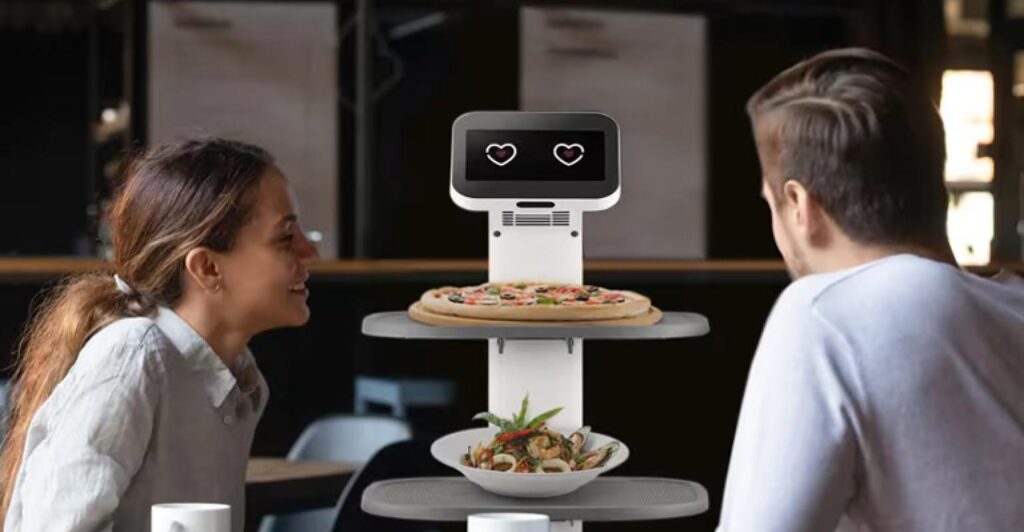Tech Tracker: How robots are finding their way on the restaurant floor
RobotLab unveiled new technology that allows humans to call robots and assign them to tables.
17 June 2024
Share this exclusive content from Saladplate

Robot servers are about to get a lot more useful. | Photo Credit: RobotLab
One of the most crucial rules of food tech investment is to avoid implementing “technology for technology’s sake.” Although robotics have infiltrated the restaurant industry for quite some time, many multi-unit operators have just beta tested robots in front or back of the house rather than rolling them out to the whole system. Additionally, for the past couple of years at conferences like the National Restaurant Association Show, fewer robots have been on display, as operators debate if they’re too expensive or unwieldy to be useful, or if robots are more flash than substance as tech problem-solvers.
This month, there have been a few robotics announcements that move the needle toward automation equipment as a more useful and standardized part of restaurant operations, like RobotLab unveiling new tech that allows servers to summon robots on demand and assign them to tables like a human employee. Additionally, Picnic Works — the pizza automation system — is partnering with Roboworx to roll out their autonomous pizza stations nationally.
Tech Tracker rounds up what’s happening in the technology sector of the restaurant industry, including news from restaurants, vendors, digital platforms, and third-party delivery companies. Here’s a breakdown of what you need to know and why:
RobotLab rolls out new robot systems
RobotLab, the Dallas-based robotics integrator, announced this month the rollout of two new tech systems to help implement robotics within a restaurant’s operations infrastructure. Both technology updates are currently compatible with Bear Robotics’ Servi and Servi+ robots.
- Robot on Call is a robot-compatible smart watch that lets servers and managers “call” robots to a table or area in need.
- ServeSwift lets managers and servers assign robots to tables via QR code, allowing robots to be programmed remotely as opposed to using their built-in hardware. Guests scan the QR code, enter their receipt number and then the robot knows where to send the order.
“Both products are designed to help restaurant and venue owners make their staff more efficient with the use of technology,” Elad Inbar, Founder and CEO of RobotLab, said in a statement. “ServeSwift… reduces the need for restaurant staff to make multiple trips around the facility to locate guests and eliminates the need for hardware solutions like buzzers. Robot on Call enables staff members to summon a robot to any location within the restaurant….This system enhances restaurant efficiency by maximizing the time servers spend in the dining room, thereby reducing the need for constant trips back and forth to the kitchen.”
The technology is already in use at several restaurants, including Area 254 in Texas, which deploys three robots, 10 smart watches, and implements ServeSwift tableside at each of the restaurant’s 70 tables.
Picnic Works and Roboworx partner for national rollout of pizza automation system
The Picnic Pizza Station — a forerunner of the automated pizza assembly line movement — is partnering with Roboworx, a subsidiary of Administrative Resource Options Inc., to roll out the automated pizza-making technology nationally.
Roboworx is tasked with providing ongoing support and preventive maintenance so that Picnic’s customers can deploy and utilize their pizza-making robots without “interrupting core business activities,” which will allow for the more seamless rollout of this technology to pizza-makers around the country.
“At Picnic, our expertise in food and technology drives us to constantly innovate,” Michael Bridges, CEO of Picnic, said in a statement. “To ensure the seamless deployment and support of Picnic Pizza Stations across the country, we sought out a dedicated partner. Finding Roboworx, with their exceptional automation expertise, perfectly aligns with our mission to help our customers thrive.”
Givex and Brightloom lean on AI for personalized guest experiences
AI has been deployed in many ways across the restaurant industry in recent years, but one of the more popular uses is to marry AI with customer data to create a more personalized and customized foodservice experience.
Most recently, Givex and Brightloom both made announcements regarding new AI capabilities that promise to “de-generalize” the restaurant consumer experience:
Givex announced the launch of EngageAI, an AI platform that can build customer profiles based on guests’ interaction with an operator, from loyalty programs to credit card transactions. Based on this data, EngageAI can create personalized marketing campaigns like sending custom push notifications and text messages based on guest behavior.
“We’re seeing a shift away from cookie-cutter marketing programs, and GivexEngageAI enables businesses to send relevant communications to each customer based on their profile and purchase history,” Mo Chaar, chief commercial officer of Givex, said in a statement. “Through a streamlined platform that eliminates the need to consolidate data from multiple sources, this solution will allow businesses to cultivate deeper customer relationships effortlessly and increase customer conversion and retention.”
Brightloom’s AI solution takes the form of a chatbot called Answers. Using generative AI technology, Answers can find solutions to marketing questions posed by operators based on customer insights. Examples of questions Answers can tackle include, “What are my restaurant’s most popular menu items?” and “What is a personalized marketing campaign I can use for my most frequent customers?”
“Consumers increasingly expect personalized engagement and experiences tailored to their preferences, behaviors, and habits, ” Kellie Zimmerman, CEO of BrightLoom, said in a statement. “However, most restaurants and businesses today, unless they have a data scientist, struggle to glean real intelligence. We’re democratizing data access and bringing all the tools and insights of big chains like Starbucks to everyone in a digestible way that will enable them to take back control.”
Answers is provided as a subscription service and costs $89 per location as an add-on for Brightloom customers.
NCR Voyix and Aloha upgrade tableside payment tech
While QR code technology has been getting some flak recently from both customers who want classic menus back and operators who feel that virtual menus are not the tech solution we thought it was four years ago, QR code technology is still evolving.
NCR Voyix announced this month the launch of Aloha Pay-at-Table powered by Sunday, which allows customers to scan a QR code to view their itemized bill, split costs with tablemates, pay, and tip in less time than other tableside payment solutions would take.
While NCR Voyix is not the first tech company to introduce QR code tableside payments, the trend of shrinking tech hardware and expanding QR code capabilities continues to grow.
Thanx and Bite collaborate to bring loyalty integrations to kiosks
Loyalty platform Thanx and kiosk solutions company Bite announced a partnership that will allow fast-casual and quick-service operators to integrate their loyalty programs within kiosk technology.
This is a nod to the trend toward technology standardization across platforms, as it allows customers to access loyalty points and rewards at an in-store ordering kiosk in the same way they would on a website or app. Customers can build their order, input their loyalty account details, and then see their points and applicable rewards on the screen before paying.
“In today’s competitive landscape, delivering a personalized and rewarding experience at every touchpoint is paramount, and this collaboration positions our customers at the forefront of this trend,” Brandon Barton, CEO of Bite, said in a statement.

Source: Nation’s Restaurant News



